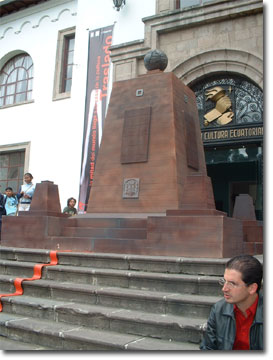Casa de la Cultura Ecuatoriana,
Apr 16, 2005 - May 10, 2005
Quito, Ecuador
La Mitad del Mundo...
by Bill Kelley Jr.
Living in London and Quito both Ribadeneira and García alternately straddle both the vertical and horizontal lines that grid the planet in zones of differentiation - the Equatorial line and the Greenwich line; lines that at once cut and unify the globe under the narratives of commerce and knowledge. Then again, one could read this project as a personal manifesto of sorts, dealing with immigration, identity, notions of globalized and nomadic existences - not an unrelated topic, but more centered around the body, for sure. Since the economic meltdown Ecuador suffered in 2001, tens of thousands of people, mainly the indigenous poor, have left the country in search of work. This mass exodus, still in effect, is unprecedented - bodies moving and relocating, the grid meaning nothing except as a site for work and opportunity. These lines, that have named nations, are indeed imaginary.
Consideration #2: The public trust, the currency of the museum, has increasingly less to do with the effectiveness of museums to be critical. In the United States, for example, the embrace of corporate sponsorship not only highlights the "crisis of the Left" within these institutions (part of a greater dilemma, most certainly), but further erodes the luster of implacability. The nature of financial networks and spectacle implicit in cultural tourism, mirrored in this exhibit, speaks to this erosion and the theoretical crisis it doubles - the mirroring of a monumental/crisis. Museums linked to the political whims of the ruling party in Latin America, as in the case with La Casa de Cultura and other state sponsored museum venues, must be subject to critical scrutiny (Miss Cartagena recently resigned protesting such political intervention). The opportunity to be global and to exchange within a contemporary art discourse is limited by a system that favors the easel and the comfortable. The strategy of engagement for the artist, critic, and curator, whose vehicles of engagement are often limited to those outside its national borders, is a key factor in the art making process. Within Ecuador this is very much the case. With few galleries to sponsor new work, an emerging but still regional international art biennial, a very small collecting base, and an unresponsive bureaucracy-laden museum system, projects that take on the practice of making art under such conditions, are political gestures indeed. In this sense, the work, "La Mitad del Mundo", as with other self-reflexive investigations of institutional critique questions the logic and process of such systems.
The show ended with a recent plaque dedication inside the museum, located near other plaques commemorating other important civic and political events to have taken place inside this important building; this particular plaque marking the day when the center of the world crossed through the museum itself. In a Borgian moment, the center of the world, the world center, was briefly brought to the periphery - a municipal museum in Quito - to bear witness, to quietly implicate, its own logic. In an act befitting the Belgian conceptualist Marcel Broodthaers whose ironic institutional plaques are a double edged sword acting as both parody as they are critiques of the logic of art history and the legitimizing space of the museum itself, the Traslado exhibit is as political a gesture as one could make.
Given the unforeseen timing of the show’s opening, this serendipitous opportunity to speak of politics in this way was understandably lost in other more pressing discussions, and yet, the gesture remains - a souvenir to remind us of what transpired. Well, isn't that what plaques are for anyway?
|











